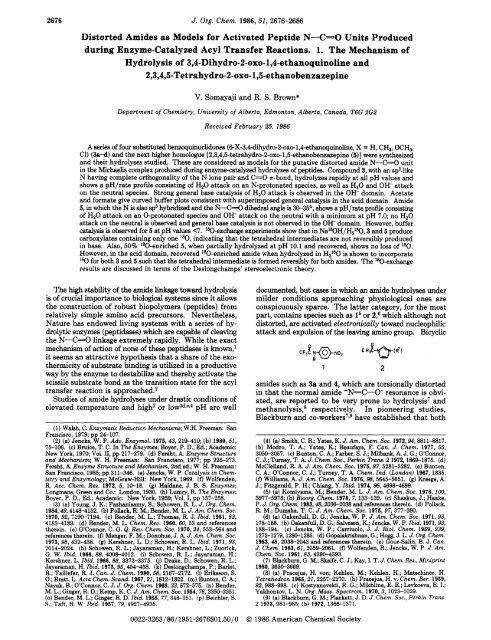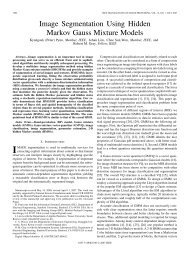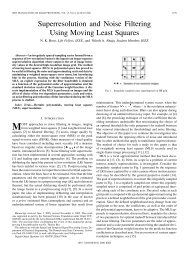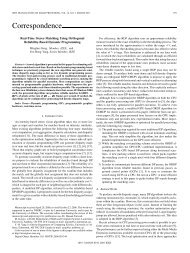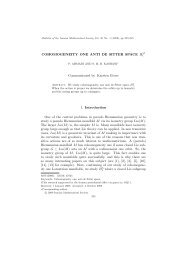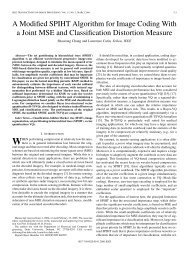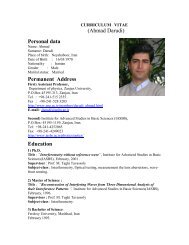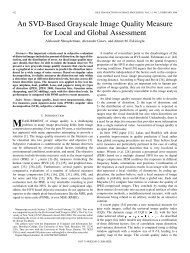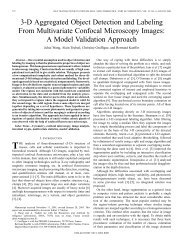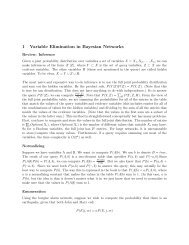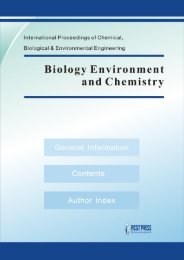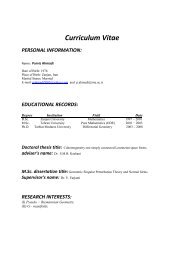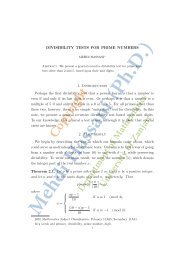Org. Chem. 1986,51, 2676
Org. Chem. 1986,51, 2676
Org. Chem. 1986,51, 2676
You also want an ePaper? Increase the reach of your titles
YUMPU automatically turns print PDFs into web optimized ePapers that Google loves.
<strong>2676</strong> J. <strong>Org</strong>. <strong>Chem</strong>. <strong>1986</strong>,<strong>51</strong>, <strong>2676</strong>-2686<br />
Distorted Amides as Models for Activated Peptide N-C=O Units Produced<br />
during Enzyme-Catalyzed Acyl Transfer Reactions. 1. The Mechanism of<br />
Hydrolysis of 3,4-Dihydro-2-oxo-l,4-ethanoquinoline and<br />
V. Somayaji and R. S. Brown*<br />
Department of <strong>Chem</strong>istry, University of Alberta, Edmonton, Alberta, Canada, T6G 2G2<br />
Received February 25, <strong>1986</strong><br />
A series of four substituted benzoquinuclidonea (6-X-3,4-dihydro-2-oxo-1,4-ethanoquinolie, X = H, CH3, OCH3,<br />
C1) (3a-d) and the next higher homologue [2,3,4,5-tetrahydro-2-oxo-1,5-ethanobenzazepine (5)] were synthesized<br />
and their hydrolyses studied. These are considered as models for the putative distorted amide N-C=O unit<br />
in the Michaelis complex produced during enzyme-catalyzed hydrolyses of peptides. Compound 3, with an sp3-like<br />
N having complete orthogonality of the N lone pair and C=O n-bond, hydrolyzes rapidly at all pH values and<br />
shows a pH/rate profile consisting of H20 attack on an N-protonated species, as well as H20 and OH- attack<br />
on the neutral species. Strong general base catalysis of HzO attack is observed in the OH- domain. Acetate<br />
and formate give curved buffer plots consistent with superimposed general catalysis in the acid domain. Amide<br />
5, in which the N is also sp3 hybridized and the N-C=O dihedral angle is 30-35', shows a pH/rate profiie consisting<br />
of HzO attack on an 0-protonated species and OH- attack on the neutral with a minimum at pH 7.0; no H,O<br />
attack on the neutral is observed and general base catalysis is not observed in the OH- domain. However, buffer<br />
catalysis is observed for 5 at pH values
Distorted Amides as Models<br />
C-N-C(O)-C angle straing and N -C=O torsional strain'<br />
(for which 3 and 4 could be considered the ultimately<br />
strained examples) contribute greatly to the reactivity of<br />
amides toward nucleophilic attack. TheFe authors have<br />
presented and analyzed a pH vs. log kOw profile for the<br />
hydrolysis of 3a from pH 5 to 10. They have observed<br />
general base catalysis at pH >8 with a Brernsted /3 of 0.8<br />
but no general catalysis below pH 7.l Effects of ring<br />
substituents on the hydrolysis were not studied nor were<br />
180-labeling studies done which would probe the reversible<br />
formation of tetrahedral intermediates.<br />
3a X-H 4 5<br />
b X=CH3<br />
C XIOCHi<br />
d X=CL<br />
Several questions therefore remain with respect to the<br />
course of hydrolysis of this type of strained amide. In this<br />
study, we have determined complete pH/rate profiles for<br />
3a-d in order to delineate the sensitivity of the various<br />
kinetic parameters to substituent effects. Secondly, in<br />
order to determine how a change in N-C=O dihedral<br />
angle from 90" (as in 3) to -30-35O influences the hy-<br />
drolysis, we have synthesized and studied the kinetics of<br />
hydrolysis of 5. Finally, we considered the extent of re-<br />
versal of formation of the intermediates produced from 3<br />
and 5 in acid and base. The general scheme for base<br />
hydrolysis of amides is that in eq 1 wherein reversible<br />
addition of OH- occurs to give a tetrahedral intermediate<br />
(T). The extent to which T partitions to form products<br />
0<br />
R'>NqR t OH- & h- t<br />
Ar 2<br />
or starting materials depends on structure, but generally<br />
kl > (k2[OH-] + k, + kB[B] + kBH[BH]).l0 lS0-labeled<br />
primary and secondary benzamides3" (but not tertidm)<br />
when treated with NaOH/H20 at elevated temperatures<br />
show substantial loss of l80 in the reisolated starting<br />
material. In acid hydrolysis, only a miniscule l80 loss is<br />
seen in recovered benzamide,3d indicating that formation<br />
of the tetrahedral intermediate (T+ in eq 2) is substantially<br />
rate limiting. In order to determine the effect of torsional<br />
strain on the extent of reversal in both acid and base, we<br />
have conducted the hydrolyses of 50% 180-labeled 3a, 3c,<br />
and 5 under various conditions.<br />
Experimental Section<br />
a. Materials. Buffers MES (morpholinoethanesulfonic acid),<br />
MOPS (morpholinopropanesulfonic acid), HEPES [N-(2-<br />
hydroxyethyl)piperazine-N'-2-ethanesulfonic acid], TRICENE<br />
(10) (a) For the acyl-activated amide such as CF3CON(CH8)CsH6, the<br />
observation of nonlinear plots of [buffer] VB. koM is interpretable in tem<br />
of a change in mechanism whereby at high [buffer] the rate-limiting step<br />
becomes kl[OH-].3jJ1 (b) For additional example of this phenomenon in<br />
the hydrolysis of N-substituted 2&dimethylmaleamic acids, see: Aldersley,<br />
M. F.; Kirby, A. J.; Lancaster, P. W.; McDonald, R. S.; Smith, C.<br />
R. J. <strong>Chem</strong>. SOC., Perkin Trans. 2 1974,1487-1495. Kluger, R.; Chin, J.;<br />
Choy, W.-W. J. Am. <strong>Chem</strong>. SOC. 1979,101,6976-6980.<br />
(11) (a) Mader, P. M. J. Am. <strong>Chem</strong>. SOC. 1965,87, 3191-3195. (b)<br />
Eriksson, S. 0. Acta <strong>Chem</strong>. Scand. 1968, 22, 892-906.<br />
"<br />
J. <strong>Org</strong>. <strong>Chem</strong>., Vol. <strong>51</strong>, No. 14, <strong>1986</strong> 2677<br />
R1' AH2<br />
[N-(tris(hydroxymethyl)methyl)glycine], TRIS [tris(hydroxymethy1)aminomethanel<br />
, BISTRIS [ (bis(2- hydroxyethy1)imino)tris(hydroxymethyl)methane],<br />
CHES [2-(cyclohexy1amino)ethanesulfonic<br />
acid], and CAPS [ 3-(cyclohexylamino)propanesulfonic<br />
acid] were reagent grade (Sigma). DzO and HJ80 (Merck,<br />
Sharp & Dohme Canada) were 99.7% and 97.2% isotopically pure,<br />
respectively. Acetonitrile (reagent grade) was purified by double<br />
distillation from PzOs and stored over 3-A molecular sieves. THF<br />
was freshly distilled from Nao (benzophenone ketyl indicator)<br />
under NZ. Benzene, (AnalaR) was freshly distilled from NaO prior<br />
to use.<br />
Routine 'H NMR spectra were recorded with a Bruker WP-80<br />
spectrometer, while spectra of the final compounds (3a-d, 5) were<br />
recorded with a Bruker WP-200 spectrometer. I3C NMR spectra<br />
were recorded at 100.6 MHz with a Bruker WH-400 spectrometer.<br />
Routine IR spectra were recorded with a PE Model 297 IR<br />
spectrophotometer. Maas spectral analyses were performed with<br />
an AEI MS-50 high-resolution mass spectrometer. Negative ion<br />
FAB mass spectra (argon impinging on glycerol matrix containing<br />
the compound) were recorded with an AEI MS-9 spectrometer<br />
locally modified.12 Mass spectrometric determination of reisolated<br />
amide 1sO/160 ratios were carried out on an AEI MS-12 mass<br />
spectrometer.<br />
b. Syntheses. Compounds 3a-d were prepared by routes<br />
analogous to that reported by Blackbum et al.' for the preparation<br />
of 3a. The 6-chloro-, 6-methyl-, and 6-methoxy-N-@-tolylsulfonyl)-4oxo-1,2,3,~-tetrahydroquinole<br />
starting materials were<br />
prepared by an analogous procedure to that reported for N-(tolylsulfonyl)-4-oxo-l,2,3,4-tetrahydroquin0line.~~<br />
The major modification to the syntheses of 3a-d related to the<br />
conditions utilized for the final synthetic step to construct the<br />
bicyclic amide. We found dicyclohexylcarbodiimide (DCC) to be<br />
more convenient than the reported' closure using triethylamine<br />
and ethyl chl~roformate.~~ In a typical experiment 1 mmol of<br />
6-X-1,2,3,4-tetrahydroquinoline-4-acetic acid was dissolved in 20<br />
mL of dry acetonitrile followed by 1 mL of a 1.0 M solution of<br />
DCC in CH3CN (1 "01). The resultant mixture was shaken for<br />
a few min to ensure homogeneity and then allowed to stand at<br />
room temperature. In 10-20 min, Na'-dicyclohexylurea began<br />
to form as white needles. After 4 h, the reaction was essentially<br />
complete (as evidenced by IR analysis), at which time the mixture<br />
was filtered and the filtrate evaporated under reduced pressure<br />
below room temperature to yield a faint yellow oil, isolated yield<br />
>90%. Physical characteristics for the final compounds 3a-d are<br />
as follows.<br />
3a: IR (film) 1755 cm-'; 'H NMR (CDCI,) d 7.35 (m, 4 H), 3.5<br />
(m, 1 H), 3.41 (m, 1 H), 3.12 (m, 1 H), 2.55 (m, 2 H), 2.00 (m, 1<br />
H), 1.75 (m, 1 H); mass spectrum, m/z 173.0839 (calcd for Cll-<br />
HiiNO, 173.0840).<br />
3b: IR (film) 1750 cm-'; 'H NMR (CDClJ 6 7.20 (m, 3 H), 3.48<br />
(m, 1 H), 3.40 (m, 1 H), 3.15 (m, 1 H), 2.50 (m, 2 H), 2.25 (8, 3<br />
H), 1.95 (m, 1 H), 1.70 (m, 1 H); mass spectrum, m/z 187.0997<br />
(calcd for C12H13N0, 187.0998).<br />
3c: IR (film) 1752 cm-'; 'H NMR (CDC13) 6 7.10 (m, 3 H), 3.80<br />
(8, 3 H), 3.45 (m, 1 H), 3.10 (m, 1 H), 2.50 (m, 2 H), 1.90 (m, 1<br />
H), 1.70 (m, 1 H); mass spectrum, m/z 203.0950 (calcd for Clz-<br />
H13NO2, 203.0947).<br />
3d: IR (film) 1755 cm-'; 'H NMR (CDC13) 6 7.35 (m, 3 H), 3.60<br />
(m, 1 H), 3.42 (m, 1 H), 3.12 (m, 1 H), 2.55 (m, 2 H), 2.05 (m, 1<br />
(12) Modified by Dr. A. Hogg, __ Department of <strong>Chem</strong>istry, University<br />
~<br />
of Alberta.<br />
(13) Johnson, W. S.; Woroch, E. L.; Buell, B. G. J. Am. <strong>Chem</strong>. SOC.<br />
1949, 71, 1901-1905.<br />
(14) Denzer, M.; Ott, M. J. <strong>Org</strong>. <strong>Chem</strong>. 1969,34, 183-187.<br />
Ti
2678 J. <strong>Org</strong>. <strong>Chem</strong>., Vol. <strong>51</strong>, No. 14, <strong>1986</strong><br />
P O o H<br />
Tos<br />
60 X:H<br />
b X : CHI<br />
C X:OCHj<br />
d X:Cl<br />
5 4 DCC'CH3CN<br />
Scheme I<br />
7<br />
&lOH/ElOH<br />
10 A<br />
COCH NI<br />
To s<br />
COOEt<br />
IHCl/ElOH<br />
d<br />
COOEt<br />
2.HCI (pHs<strong>51</strong><br />
H), 1.80 (m, 1 H); mass spectrum, m/t 207.0462 (calcd for Cll-<br />
Hl@1036C1 207.0459).<br />
2,3,4,5-Tetrahydro-2-oxo-1,5-ethanobenzazepine (5). This<br />
was prepared by the sequence given in Scheme I. Ethyl-N-(ptolylsulfonyl)-l,2,3,4-tetrahydroquinoline-4-acetic<br />
acid (6)' (3.5<br />
g, 10 mmol) was converted to the corresponding acid chloride by<br />
treatment with neat SOCl, with precautions taken to exclude<br />
moisture. After removal of excess SOCl, under reduced pressure,<br />
the residue was dissolved in 25 mL of dry ether and the entire<br />
solution cooled to 0 "C. This solution was added slowly to a cooled<br />
(0 "C) solution of diazomethane (1.2 g, 30 mmol) in 100 mL of<br />
ether with constant swirling. The solution was allowed to come<br />
to room temperature for 1 h, after which time the volatiles were<br />
removed under reduced pressure.<br />
The crude diazo ketone 7 (IR 2150,1680 cm-') was dissolved<br />
in 50 mL of ethanol kept at 50-60 OC. A slurry of Ag,O (1 g) in<br />
10 mL of ethanol was slowly added to the first solution with<br />
vigorous stirring over a period of 30 min, after which the mixture<br />
was boiled for an additional 30 min, cooled, and fiitered. Removal<br />
of the volatiles under reduced pressure gave 2.3 g of 8 (58% crude<br />
yield from 6). HC1-catalyzed removal of the N-toluenesulfonate<br />
group as described7 yielded 40% of the ester 9: 'H NMR (CDC13)<br />
6 7.0 (m, 2 H), 6.60 (m, 2 H), 4.15 (9, 2 H), 3.82 (br s, 1 H), 3.40<br />
(m, 2 H), 2.88 (m, 1 H), 2.45 (m, 2 H), 1.95 (m, 4 H), 1.26 (t, 3<br />
H); mass spectrum, m/z 233.1418 (calcd for C14Hl$J02, 233.1417).<br />
1,2,3,4-Tetrahydroquinoline-4-propanoic Acid ( 10). This<br />
was prepared from 9 in a fashion analogous to that described for<br />
the lower h~mologue:~ IR (film) 3400,3250,1720 cm-'; 'H NMR<br />
(CDCl,) 6 7.15 (br s, 2 H), 7.00 (m, 2 H); 6.55 (m, 2 H), 3.25 (m,<br />
2 H), 2.90 (m, 1 H), 2.50 (m, 2 H), 1.95 (m, 4 H); mass spectrum,<br />
m/z 205.1103 (calcd for C12HlSN02, 205.1103).<br />
2,3,4,5-Tetrahydro-2-oxo-1,5-ethanobenzazepine (5). Amide<br />
5 was synthesized from 10 by treatment with DCC in the fashion<br />
described above for the general synthesis of 3 IR ( fi) 1705 cm-';<br />
lH NMR (CDCl,) 6 7.35 (m, 4 H), 4.01 (m, 2 H), 3.34 (m, 2 H),<br />
2.63 (m, 2 H), 2.00 (m, 2 H), 1.85 (m, 2 H), 2.05 (m, 1 H), 1.65<br />
(m, 2 H); mass spectrum, m/z 187.0999 (calcd for ClzH13N0,<br />
187.0998).<br />
c. Kinetics. Kinetic data were obtained by observing the rate<br />
of increase in absorbance of 3 X lo4 M aqueous solutions of amide<br />
at the wavelength of maximum change (290 nm, 3a; 297 nm, 3b;<br />
306 nm, 3c; 302 nm, 3d; 291 nm, 5) with a Cary 210 UV-vis<br />
spectrophotometer interfaced as previously de5~ribed.l~ Buffer<br />
solutions of four to five concentrations between 0.02 and 0.15 M<br />
were used (HCl, pH C2; formate, pH 3.1-4.0; acetate, pH 4.0-5.1;<br />
MES, PH 5.1-6.5, MOPS, PH 6.5-7.6; HEPES, PH 7.0-8.1;<br />
TRICENE, p~ 8.0-8.7; CHES, PH 9.0-9.8; CAPS, PH 9.8-11.1;<br />
NaOH, pH >11.0). Stock solutions of amide in CH3CN were<br />
prepared and the reactions initiated by injecting 10 jtl of the stock<br />
into a 1.0-an quartz cuvette containing 3.0 mL of buffer solution<br />
which had been previously equilibrated in the instrument cell<br />
holder for 20 min at 25.0 f 0.2 "C. All reactions were followed<br />
to at least 3 half-lives and displayed excellent pseudo-first-order<br />
kinetics. Pseudo-first-order rate constants (kow) were obtained<br />
by nonlinear least-squares fitting of the absorbance vs. time data<br />
to a standard exponential m0de1.l~<br />
Each determination was repeated in triplicate and has a precision<br />
of better than 3%. Data shown in the fies were obtained<br />
from plots of koM vs. [buffer] at a given pH, the reported values<br />
Somayaji and Brown<br />
being those extrapolated to zero ionic strength and [buffer]. For<br />
the studies to determine curvature in the [buffer] vs. kow plots,<br />
acetate buffers at pH 5.10 and 4.50 were made up to varying<br />
concentrations, the ionic strength being held constant at 0.4 M<br />
with KC1. Tables of primary kow data are given as Supplementary<br />
material.<br />
Data for faster reactions (kow > 0.1 8-l) were obtained with<br />
a Durrum-Gibson 115 stopped-flow kinetics system interfaced<br />
to a micr~omputer.'~ Values reported are the averages of four<br />
to eight separate determinations and have a precision of better<br />
than 3%. Into one drive syringe was placed the main buffer<br />
solution (0.0s-O.80 M), while the second syringe contained 5 mL<br />
of a very dilute M HEPES) buffer held at pH -8, (corresponding<br />
to the conditions of slowest hydrolysis for the amide).<br />
Both solutions were thermostated at 25.0 OC for 20 min, after<br />
which time 20-30 pL of stock solution of amide in CH3CN was<br />
injected into the dilute buffer. Kinetic determinations were<br />
immediately commenced, the amides 3a-d lasting long enough<br />
under these conditions to allow four runs. If necessary, the entire<br />
procedure was repeated, to record additional readings. The pH<br />
of the effluent was measured and taken to be that of the reaction<br />
medium, assuming instant equilibration.<br />
In general, pH measurements during preparation of the aqueous<br />
buffers were made with a Fisher 825 MP meter using separate<br />
Fisher glass and calomel electrodes. pH measurements of the<br />
reaction mixtures after a kinetic run were made with a Radiometer<br />
TIT2 unit and Radiometer GK-2321C combination electrode and<br />
showed no change during the course of reaction. Electrodes were<br />
standardized with certified pH 4.00,7.00, and 10.00 buffers prior<br />
to use.<br />
Deuterated buffers were prepared either by dissolving HCOzH<br />
(pD 3.1) or HEPES (pD 8.0) in 99.7% D20 (to a final concentration<br />
of 0.1 M) and adjusting the pD with NaOD (prepared by<br />
addition of Nao to D20). The addition of this amount of HC02H<br />
alters the deuterium content by -0.1% and was assumed not to<br />
influence the results. pD was determined by adding 0.4 uniP<br />
to the readings obtained with the above devices.<br />
Energies of activation were determined graphically from plots<br />
of log kow vs. 1/T at three to four different temperatures.<br />
d. 180-Exchange Studies. 1. Qualitative Mass Spectral<br />
Analysis. Amides 3a-d and 5 (-5 mg) were dissolved in a<br />
solution consisting of 5 jtL of CH&N and 5 jtL of H2'80. A small<br />
amount of this solution was injected directly into the mass<br />
spectrometer at various time intervals and the spectrum recorded<br />
for both the amide and carboxylic acid regions. The procedure<br />
was repeated until hydrolysis was complete. For '*O-exchange<br />
experiments at pH 12) and a small droplet of this mixed with glycerol and<br />
injected into the chamber. For the latter two sets of determinations,<br />
only the carboxylic acid was monitored for incorporation<br />
since the reaction is very fast. Control experiments were conducted<br />
under all the above conditions to determine if the authentic<br />
carboxylic acid exchanged this only occurred under strongly acidic<br />
conditions.<br />
2. Quantitative l80 Mass Spectral Analysis. For these<br />
experiments 50% 180-incorporated amide was synthesized and<br />
subjected to hydrolysis under conditions nearly identical with<br />
those used for the kinetic experiments. Unreacted amide was<br />
reisolated after about 1 and 2 half-lives and subjected to mass<br />
spectrometric analysis. Percent l80 content for all subsequent<br />
experiments is determined as (ZM + 2) (ZM + + ZM) where Z =<br />
intensity and M + 2 and M are the d 0 and l60 parent peaks.<br />
Reported values in the tables are averages of four to six determinations<br />
for a given experiment.<br />
The following synthesis of '*O-enriched 3a is representative.<br />
To 122 mg of detosylated 6a (Scheme I) in an oven-dried 5-mL<br />
flask fitted with a reflux condensor were added 600 mg of 98%<br />
H,lsO, concentrated HC1 (56 mg), and 476 mg of H2160. The<br />
solution was heated at 100 "C for 18 h, cooled, brought to pH 5.0<br />
(15) Brown, R. S.; Ulan, J. G. J. Am. <strong>Chem</strong>. Soc. 1983,105,2382-2388. (16) Fife, T. H.; Bruice, T. C. J. Phys. <strong>Chem</strong>. 1961, 65, 1079.
Distorted Amides as Models J. <strong>Org</strong>. <strong>Chem</strong>., Vol. <strong>51</strong>, No. 14, <strong>1986</strong> 2679<br />
by the addition of 8 M NaOH (in Hz160), and extracted with 3<br />
x 2 mL of CHZCl2. The combined CHzClz extracts were diluted<br />
with 5 mL of acetonitrile, decolorized with charcoal, and fiitered.<br />
On removing all volatiles 70 mg (57%) of the 180-enriched acid<br />
was obtained. The enriched acid was cyclized in an acetonitrile<br />
solution containing equimolar DCC as described above to quantitatively<br />
yield the amide which contained 48.8 f 0.8% "0 as<br />
judged by comparison of the M + 2 and M peaks in the mass<br />
spectrum. In a similar fashion were prepared enriched 3c and<br />
5.<br />
Reisolation of starting amide must be carried out quite quickly<br />
since 3a,c and 5 hydrolyze rapidly. To retard the rate of hydrolysis<br />
of 3a,c the reaction was performed at 11 OC in a pH 6.5 or 6.8,<br />
0.04 M MOPS buffer containing 10% CH3CN. Independent<br />
kinetic analysis, done as described above, established that T1p<br />
for 3a under these conditions is 247 s, while T1 for 3c is 181 s.<br />
The general reisolation procedure is typified by the following<br />
experiment for 5.<br />
A stock solution of 48.0 f 0.45% lS0-enriched 5 (4.8 mg in 0.2<br />
mL of CH3CN) was added to 10 mL of rapidly stirred acetate<br />
buffer (pH 4.5,O.lO M) containing 0.8 mL of CH3CN (for reasons<br />
of improved solubility) and thermostated at 25.0 "C. After 680<br />
s (1 half-life) the reaction mixture was quickly poured into 10 mL<br />
of freshly distilled CH2C12 and shaken in a 30-mL separatory<br />
funnel and the lower layer run immediately onto anhydrous<br />
Na2S04 (10 g). Extraction of the aqueous layer with a second<br />
10-mL portion of CHzClz followed by drying of the combined<br />
organic layers and solvent removal under reduced pressure (T<br />
< 20 "C) yielded -4 mg of material comprised of unreacted amide<br />
and product acid 10. This was dissolved in -20 WL of dry CH3CN<br />
and directly analyzed by mass spectrometry. To obtain the results<br />
for 2 half-lives, a second experiment was carried out analogously<br />
to the above, with the exception that the isolation was commenced<br />
at - 1300 s. Rate constants for lSO exchange were determined<br />
from the slopes of plots of In (IM + 2) / (IM + 2 + IM) as a function<br />
of time. The data summary for 3a,c and 5 are presented in Table<br />
IV, while primary data are given in Table S5 (supplementary<br />
material).<br />
3. l%-lsO NMR <strong>Chem</strong>ical Shift Experiments. For reasons<br />
of solubility, the amide (100-200 mg) was dissolved in 0.5 mL of<br />
CD3CN containing H2180 (45-75 WL for 3 and 5, -10-20 vol %)<br />
and the full proton-decoupled 13C-spectrum obtained at various<br />
time intervals. For 3 which hydrolyzes relatively quickly under<br />
these conditions, every 500-1000 scans were summed separately<br />
(the time being recorded as the midpoint of the number of scans<br />
utilized), and the process was repeated until the amide was no<br />
longer observed. For 5, the reaction was very slow, and the spectra<br />
were collected at various time intervals over a period of 3 days.<br />
The percentage of l80 incorporation in both amide and product<br />
acid was judged from the relative peak heights of 1sO/160 amide<br />
and '80,'80/180,1e0 acids, respectively. l80 incorporation is evidenced<br />
by the appearance of a new peak attributable to an<br />
180-induced isotope shift of the carbonyl 13C resonance." Control<br />
experiments with 50% lsO-incorporated 5 shows that the 13C=1s0<br />
resonance of the amide appears 4.3 Hz upfield from the 13C=160<br />
resonance at 187.6 ppm. The ratio of peak intensity is 49.1/50.9<br />
(Ic=ieo/Ic=iy,) while the mass spectrometric ratio is 48 f 05/52<br />
* 0.5.<br />
Results<br />
a. Kinetics. Shown in Figure 1 are the buffer-inde-<br />
pendent pH vs. log kom profiles for 3a and 5. The profiles<br />
for amides 3b-d are nearly superimposable on that for 3a<br />
and for reasons of clarity are not illustrated. (The pseu-<br />
do-fiist-order rate constant data from which the plots were<br />
constructed are available in Tables S1 and S2, supple-<br />
(17) For leading references to the 1s0-'3C chemical shift methodology<br />
as it pertains to dynamic exchange, see: (a) Parente, J. E.; Risley, J. M.;<br />
Van Etten, R. L. J. Am. <strong>Chem</strong>. SOC. 1984,106,<strong>51</strong>56-8161. (b) Risley, J.<br />
M.; Kuo, F.; Van Etten, R. L. Ibid. 1983,105,1647-1652. (c) Risley, J.<br />
M.; Van Etten, R. L.; Uncuta, C.; Balaban, A. T. Ibid. 1984, 106,<br />
7836-7840. (d) Van Etten, R. L.; Risley, J. M. Ibid. 1981,103,5633-5636.<br />
(e) Risley, J. M.; Van Etten, R. L. Ibid. 1981,103,4389-4392. (0 Vederas,<br />
J. C. Ibid. 1980,102,374-376. (9) Diakur, J.; Nakashima, T. T.; Vederas,<br />
J. C. Can. J. <strong>Chem</strong>. 1980,58, 1311-1315.<br />
-<br />
2<br />
- 0<br />
cn<br />
1<br />
-. 1 -1<br />
Y<br />
0 -2<br />
-3<br />
-4<br />
-5<br />
0 2 4 6 8 1 0 1 2 1 4<br />
PH<br />
Figure 1. Buffer-independent pH vs. log kow profiles for 3a (0)<br />
and 5 (0); T = 25.0 OC.<br />
Table I. Equilibrium and Rate Constant Values for Amides<br />
3a-d and 5 Evaluated by Nonlinear Least-Squares Fitting<br />
of Kinetic Data to Equations 3a and 4a, Respectively"*<br />
10-2k3, 10-'kH+,<br />
compound k,, s-l 103k2, s-l M-'s-l M-1 s-l<br />
PK.<br />
3a 4.45 2.02 2.62 3.71<br />
3b 4.06 1.6* 1.75 3.8l<br />
3c 5.31 1.6' 1.68 3.57<br />
3d 3.53 3.42 3.65 3.38<br />
5 0.6O 0.59<br />
" T = 25.0 "C; data extrapolated to [buffer] and ionic strength =<br />
0, [substrate] = 3 X lo4 M. *Standard deviation in rate constants<br />
5% and in K,, 7%. Evaluated by using K, = Primary kow<br />
data at various pH values given in Tables S1 and S2 in supple-<br />
mentary material. d kH+ = kH20/KP.H+.<br />
mentary material.) The profiles for 3a-d each exhibit<br />
domains involving H20 attack on a protonated species and<br />
an apparent H20 attack followed by OH- attack on the<br />
neutral. No terms of higher order than 1 for OH- attack<br />
are seen. The results for 3a corroborate those given by<br />
Blackburn et alS7 with the notable exception that at high<br />
[H,O+], the kobd values here tend to become pH independent.<br />
This indicates a relatively high pK, (3.5-4) for<br />
3-H+ and suggests that the site of protonation is N.lS The<br />
profile for 5 consists of two domains requiring H20 attack<br />
(18) Normally simple N-protonated amides have pK, values of -8 to<br />
-6,1094r while 0-protonated amides have pK, values on the order of -2 to<br />
0.19 The relative acidities can be rationalized on the basis of simple<br />
resonance agruments. However, 3 (and to a lesser extent 5) does not allow<br />
such resonance so that the N and carbonyl group should behave as independent<br />
amino and ketonic groups but experience mutual inductive<br />
effects. Since the pK, of the C=O+H unit is expected to be even lower<br />
than that of a ketone (normally -7.7 to -5 for such ketones as cyclohexanone,<br />
acetone, etc.'"), the observed kinetic pK, of -3.5 for 3a-d in<br />
the present study is attributable to the dissociation of O=CN+H. By way<br />
of comparison, the kinetic pK, of 3.71 for 3a is some 4.0 units lower than<br />
the thermodynamic pK, reported for benzoquinuclidine (7.7gZ0), in line<br />
with a significant inductive destabilization by the adjacent C=O unit.<br />
(19) (a) Arnett, E. M. Prog. Phys. <strong>Org</strong>. <strong>Chem</strong>. 1963, 1, 223-403. (b)<br />
Guthrie, P. J. J. Am. <strong>Chem</strong>. SOC. 1974,96,360&3615. (c) Arnett, E. M.;<br />
Quirk, R. P.; Larsen, J. W. Ibid. 1970,92,3977-3984. (d) Fersht, A. Ibid.<br />
1971, 93, 3504-3<strong>51</strong>5.<br />
(20) Wepster, B. M. Red. Trau. Chim. Pays-Bas 1952, 71,1171-1178.<br />
(21) (a) Jencks, W. P. Acc. <strong>Chem</strong>. Res. 1980, 13, 161-169 and references<br />
therein; (b) 1976, 9, 425-432
2680 J. <strong>Org</strong>. <strong>Chem</strong>., Vol. <strong>51</strong>, No. 14, <strong>1986</strong> Somayaji and Brown<br />
Table 11. Activation Parameters and Solvent Deuterium Isotope Effects for Hydrolysis of 3c<br />
PH T, "C koMr s-*' E,, kcal/mol AH*, kcal/mol AS', eu kH@/kD,Ob<br />
8.00' 14.1<br />
25.0<br />
1.14 x 10-3<br />
2.10 x 10-3<br />
11.0 10.4 -35.9 2.17<br />
37.2 4.<strong>51</strong> x 10-3<br />
3.2c 8.5 1.27 10.8 10.2 -19.8 2.39<br />
25.0<br />
35.5<br />
3.75<br />
6.91<br />
"koW values extrapolated to [buffer] = 0; values f5%. * T = 25 "C; pD = pH + 0.4 (Pentz, L.; Thornton, E. R. J. Am. <strong>Chem</strong>. SOC. 1967,<br />
89, 6931-6938). pH-independent regions.<br />
on 5-H+ and OH- attack on 5 with a minimum at pH 7<br />
showing no evidence of HzO attack on the neutral form.<br />
Since there is no tendency to plateau at low pH, the pK,<br />
for 5-H+ must be 8 base domain, buffer<br />
catalysis is seen for each of 3a-d. Two-point Bransted<br />
ploh constructed from the data for CAPS and CHES give<br />
0 values of 0.72,0.85,0.75, and 0.67 for 3a-d, respectively,<br />
in agreement with the value of 0.8 f 0.1 reported by<br />
Blackburn et al.' for 3a. Plots of the second-order rate<br />
constant for buffer catalysis (kB) vs. % free base indicate<br />
only the basic form is active. With the exception of<br />
HEPES and TRICENE, no buffer catalysis is seen be-<br />
tween pH 7.5 and 12 for 5. The former two buffers are<br />
particularly active as their basic forms toward 5 and, 3a-d<br />
as are other buffering agents containing a basic N and<br />
hydroxyalkyl unit. The observed kB values for HEPES<br />
and TRICENE lie well above their expected values esti-<br />
mated for the Brransted plots defined by CHES and MOPS<br />
for 3a-d and signify a different mechanism of action.<br />
Second-order rate constant data for the above buffers are<br />
presented as supplementary material in Table S3.<br />
(4)<br />
I I<br />
L" 2.6<br />
10.6 (Y<br />
2 I<br />
8 2.4<br />
0<br />
2.2<br />
I<br />
0<br />
0<br />
a<br />
e<br />
0 - 0<br />
i<br />
U<br />
c<br />
0<br />
0.4<br />
0) - 0<br />
k2<br />
l2.J 40.2<br />
I I 1 I I I I<br />
-0.2 0 0.2<br />
2-<br />
(T<br />
Figure 2. Hammett plots of log k, (right scale, O), 3 + log k2<br />
(right scale, @), and log k3 (left scale, 0) against substituent u<br />
values for 3a-d. Values of rate constants from Table I.<br />
In the neutral and acid domains, the nature of the buffer<br />
catalysis for 3 and 5 changes. For example MES gives no<br />
observed effect for 3a-d (pH 5.7-6.5) but does catalyze the<br />
hydrolysis of 5. Plots of kB vs. 90 free MES base show that<br />
both the acidic and basic forms of the buffer are active.<br />
Acetate and formate are also active toward 5. Plots of koM<br />
vs. [acetate] at pH 5.1 and 4.5 yield straight lines with<br />
slopes of 14.3 X lo4 and 28.7 X lo-' M-' s-l, respectively,<br />
while similar plots vs. [formate] at pH 4.0 and 3.6 have<br />
slopes of 5.76 X and 13.2 X M-' s-l, respectively.<br />
Acetate and formate at low concentration show quite<br />
small and almost unnoticeable effects with 3a-d, essentially<br />
corroborating Blackburn's findings with 3a. However,<br />
at high concentration a trend is discernable, this being<br />
most prominent for 3c. As shown in Figure 3 a saturation<br />
behavior exists in the plots of kobsd [total acetate] concentrations<br />
at pH 5.1 and 4.5. (Ionic strength was held<br />
at 0.4 M, KCl, but changes in ionic strength from 0.1 to<br />
0.4 M do not change the kobsd values more than 3%.)<br />
Because the buffer concentrations did not exceed 0.4 M,<br />
it is not certain whether the plots eventually become independent<br />
of [buffer] or level off at some gradual slope.<br />
This type of phenomenon is often seen in multistep reactions<br />
wherein a product-forming step proceeding from<br />
a reversibly formed intermediate is subject to buffer catalysi~.~jJ*~~J~,~~<br />
Data pertaining to the above studies are<br />
available in Table S4 (supplementary material).<br />
Imidazole appears to facilitate the decomposition of 3<br />
and 5 by uni- and bimolecular (in [imidazole]) pathways.<br />
Plots of &w vs. [free imidazole] (pH 7.5, imidazole buffer,<br />
T = 25.0 OC) yield upward curving lines which can be<br />
analyzed according to eq 5.<br />
kobsd = kblmk + k2[Im1 + k3[Im12 (5)<br />
For 3c the vdues for kbhk, Itz, and k3 are 2.25 x<br />
s-l,<br />
7.75 M-' s-l, and 334 M-2 s-l, respectively, while for 5 they
Distorted Amides as Models J. <strong>Org</strong>. <strong>Chem</strong>., Vol. <strong>51</strong>, No. 14, <strong>1986</strong> 2681<br />
Table 111. Fast Atom Bombardment Determined Peak<br />
Intensities for Various Amides and Their Product Acids<br />
Treated with Na1*OH/H2'*O"<br />
relative peak intensities,<br />
time after mlz<br />
comDound treatment? min 204 206 208<br />
3b - 15 0 100 2.8<br />
6b' (-Tos) - 20 100 2.4 0<br />
5 - 5000 0 100 4.9<br />
1 O C - 5000 100 4.2 0<br />
Glycerol matrix containing reaction mixture bombarded with<br />
argon. *Treatment consists of solid material dissolved in a few<br />
microliters of Na1*OH/HJ80 at room temperature. Product acid<br />
as identified in Scheme I.<br />
are 2.60 X 8 , 0.019 M-ls-l, and 0.102 M-2 s-l.<br />
c. l8O-Labeling Experiments. Given in Table I11 are<br />
fast atom bombardment (FAB) determined masses for<br />
product carboxylates formed from treatment of 3b and 5<br />
with 1 N Na180H/H,'80. It is clear that when the hydrolysis<br />
product from a given amide and its authentic<br />
nonenriched acid are subjected to as similar conditions as<br />
possible and compared, the ratios of the FAB-measured<br />
M + 2/M peaks are the same. No evidence of double l80<br />
incorporation is seen within the experimental limitations<br />
which we judge to be f2%. The relatively high value of<br />
the error limit stems from the cluttered appearance of the<br />
FAB spectra with adventitious glycerol peaks (from the<br />
glycerol matrix in which the carboxylates are run) surrounding<br />
the parent ions. We believe the clustering is<br />
responsible for the anomalously high amount of M + 2<br />
product for 5 and 10 and not the exchange of H2180 into<br />
the carboxylate. Control experiments in which the authentic<br />
carboxylates are subjected in the Na180H/H21s0<br />
hydrolysis medium and reanalyzed by FAB show that the<br />
carboxylates do not incorporate l80.<br />
Quantitative experiments were conducted as follows.<br />
Approximately 50% 180-enriched amides 3a, 3c, and 5<br />
were synthesized as detailed in the Experimental Section<br />
and subjected to hydrolysis in a medium consisting of 90%<br />
H,'60-containing buffer and 10% CH3CN (for solubility)<br />
at temperatures that were convenient for reisolating the<br />
amide after various time intervals. The exact conditions<br />
and results are given in Table IV with primary data given<br />
in Table S5 (supplementary material). Hydrolysis kinetics<br />
were monitored in the same buffers under the same conditions<br />
of temperature and 10% CH3CN in order to determine<br />
the conditional hydrolytic rate constants reported<br />
08<br />
"'I<br />
0.6<br />
# I 3 3 0.3<br />
Po<br />
x<br />
02<br />
0<br />
0<br />
0<br />
0<br />
0<br />
0<br />
a<br />
pH:L,50<br />
0<br />
pH = 5,lO<br />
01-<br />
0 01 02 03 01<br />
[ACETATE]<br />
Figure 3. Plots of k, d vs. total acetate concentration for the<br />
hydrolysis of 3 X 10- B" M 3c at 25 "C in HzO; p = 0.4 (KC1).<br />
in Table IV. The pseudo-first-order rate constants for l 80<br />
exchange (kex) were evaluated from the slopes of plots of<br />
In l80 content in recovered amide vs. time. The exchange<br />
reactions were followed to two half-times of hydrolysis and<br />
the plots displayed excellent linearity.<br />
In the neutral and acid domains for 3a,c (pH 6.5-6.8)<br />
and the acid domain for 5, large amounts of l80 exchange<br />
are observed. However at pH 9.8 where the kinetic profile<br />
for 3a is comprised of both a water term (k,) and hydroxide<br />
term (k3), a reduced amount of lSO exchange is observed.<br />
At pH 10.1, corresponding to the section of the kinetic<br />
profile for 5 which is first order in [OH-], the exchange in<br />
recovered amide is (within the experimental error) indis-<br />
tinguishable from zero and confirms the result from FAB.<br />
Finally in Table V we present the exchange data for 3a,c<br />
and 5 determined by 180=13C NMR chemical shift data<br />
obtained in situ from unbuffered CD,CN solutions con-<br />
taining 10-20 vol 70 H2180, the exact conditions being<br />
given in the table. We assume the "pH" of this medium,<br />
although not directly definable is between 7 and 5 since<br />
the product amino acid acts as a buffering agent. (Un-<br />
Table IV. Mass Spectrometrically Determined 180-Exchange Rates of Recovered Amides 3a, 3c, and 5 and Hydrolysis Rate<br />
Constants under Various Conditionsa<br />
~<br />
PH % l80 exchange<br />
compound<br />
(buffer)<br />
[conc, M] T, "C 103khyd,* 8-1 104k,,,e ~1 ksx/khyd<br />
Per TI/!<br />
hydrolysis<br />
3a 6.5<br />
(MOPS)<br />
[0.04]<br />
11.0 f 0.1 2.80 f 0.05 8.29 f 0.7 0.29 f 0.03 18.4 f 1.5<br />
3a 9.8<br />
(CHES)<br />
[0.02]<br />
11.0 f 0.1 4.38 f 0.09 4.65 f 0.5 0.11 f 0.014 7.2 f 0.8<br />
3Cd 6.8<br />
(MOPS)<br />
[0.04]<br />
25.0 f 0.1 3.82 f 0.07 8.98d f 1.1 0.24 f 0.03 15.0 f 1.9<br />
5 4.5<br />
(acetate)<br />
[0.10]<br />
25.0 f 0.1 1.02 f 0.02 5.26 i 0.2 0.52 f 0.03 30.1 f 1.2<br />
5 10.1<br />
(CAPS)<br />
[0.04]<br />
25.0 f 0.1 6.30 f 0.12 0.2 f 0.5 0.0028 i 0.008 0.2 f 0.6<br />
"Conditions as described in Experimental Section. *Error limits as deviation from the average of triplicate runs. 'Error limits are<br />
standard deviation of linear plots of In ('*O 9%) vs. time, three data points. dOnly two points defining plot of In (l80 %) vs. time.<br />
a
2602 J. <strong>Org</strong>. <strong>Chem</strong>., Vol. <strong>51</strong>, No. 14, <strong>1986</strong><br />
Table V. Fractional Amounts of 180-Incorporated Amide<br />
Produced during the Hydrolyses of 3a,d and 5 in CD,CN<br />
Containing 10-20 Vol % H,'*O as Determined by "C NMR<br />
Spectrometry'sb<br />
total fractional<br />
material, %" material, %b<br />
comoound time. min amide acid amide l60 amide l80<br />
3a' 3 95.3 4.7 95.3 0<br />
15 68.0 32.0 60.2 7.8<br />
45 54.6 45.4 46.7 7.9<br />
90 34.0 66.0 26.0 8.0<br />
3dd 45 68.0 32.0 63.4 4.6<br />
140 59.0 41.0 <strong>51</strong>.3 7.7<br />
5e 2880 36 64 24.5 11.5<br />
"Fractional % defined as (peak height given 13C=0 signal)/(x<br />
peak height all 13C=0 signals). For exact methodology, see Ex-<br />
perimental Section d3. bProbable accuracy f10% of value.<br />
e 613c,160 38 192.326; 813c,180 3a 192.286; 616&13c-180 acid 169.45;<br />
818&13~-180 acid 169.41. Conditions: 145 mg of 3a; 450 pL of CD3-<br />
CN; 64 pL of HZ"0; 30 "C. 613c,160 3d 191.42; 813c,180 3d 191.37;<br />
616&13~-1~ acid 169.00; bieo_i3c-i~ acid 168.96; bl6~13~-160 acid 169.04.<br />
Conditions: 170 mg of 3d; 450 pL of CD3CN; 45 pL of HZl80; 30<br />
"c. e613c,1Q 5 189.01; 813~-180 5 188.97; 616@13c-lQ (10) 176.56;<br />
613&13~..180 (10) 176.54. Conditions: 150 mg of 5; 500 pL of CD3CN;<br />
72 pL of H2180; 30 "C.<br />
jl<br />
Olminl<br />
Figure 4. Graphical representation of the appearance of the<br />
13C=0 NMR spectrum for 3a as a function of time spent in a<br />
medium consisting of 450 pL of CD3CN and 60 pL of H2180; T<br />
= 30 "C. From low field to high field the origin of the peaks is<br />
l60 amide, l80 amide, 1sO-160 acid, 180-180 acid. Details given<br />
in Table V.<br />
buffered aqueous solutions of the amides attain equilib-<br />
rium pH values of -4.7 after complete hydrolysis.) During<br />
the course of hydrolysis, the lowest field 13C=160 peak of<br />
the starting amide gives way to three additional 13C=1s0<br />
resonances, one from lSO-incorporated amide and one each<br />
from singly and doubly 180-labeled product acid. The<br />
appearance of the time-dependent 13C NMR spectrum for<br />
3a is given in Figure 4. Control experiments with 50%<br />
180-labeled 5 establish that the amide 13C=1s0 resonance<br />
is shifted 4 Hz upfield from the 13C=160 one and that the<br />
C<br />
Scheme I1<br />
-<br />
Somayaji and Brown<br />
relative intensities are representative of the actual isotopic<br />
content.22 Also, control experiments in which authentic<br />
double l60 acid was added to the NMR mixture at the<br />
completion of hydrolysis demonstrate that a new resonance<br />
appears in the spectrum -4 Hz downfield from the l60-<br />
13C-160 band. For 3a, -17% l80 incorporation in the<br />
amide occurs at one hydrolysis half-life, a result which is<br />
very similar to that obtained from the quantitative reiso-<br />
lation experiments for 3a detailed above. This would tend<br />
to indicate that the high CD3CN content does not produce<br />
a major alteration of the exchange process and that the<br />
more qualitative results obtained in solutions containing<br />
acetonitrile need not be considered as atypical of the sit-<br />
uation in H20.<br />
Discussion<br />
It is necessary at this point to consider the nature of the<br />
amide distortion in both 3 and 5. Molecular models of 3<br />
suggest that bridgehead N atom is tetrahedral with its sp3<br />
lone pair oriented coplanar with the C-O internuclear axis<br />
(i.e., orthogonal to the C=O *-bond). In 5, X-ray crys-<br />
tallographic analysisB also indicates the N to be within 5 O<br />
of a tetrahedral geometry and the relatively localized N<br />
lone pair is oriented 5 5-60O from coplanarity with the C-O<br />
internuclear axis. Thus, the distortion in these molecules<br />
is not simply that of twisting about the N-C=O bond.<br />
The distortion can best be visualized as in Scheme I1<br />
by considering a planar amide residing in the X-2 plane.<br />
Pyramidalization of the N produces a net tilt angle (9) of<br />
the lone pair away from the y axis in the x direction.<br />
Coupled with that motion is a rotation of the C,-C2-0<br />
plane about the x axis to produce a twist angle (4) of the<br />
p orbital on C away from coplanarity with the N lone pair.<br />
In terms of these motions, 9 and 4 are -15-20° and 90°,<br />
respectively, for 3a-d and -15-20° and 30-35', respec-<br />
tively, for 5, the latter being experimentally observed by<br />
X-ray crystallography.23 In actuality the asymmetry of the<br />
molecular structure in both 3 and 5 renders the *-faces of<br />
the C=O unit dissymmetric and hence it too should be<br />
somewhat pyramidalized or rehybridized from sp2 toward<br />
sp3.24 Experimentally the C=O pyramidalization in 5 is<br />
(22) As a control experiment 105 mg of detosylatd 6d (Scheme I) and<br />
97 mg of 3d (equimolar) in 500 pL of CD&N subjected to I3C NMR<br />
analysis under the exact conditions used for the 180-exchange experi-<br />
menta (pulse delay 0.5 s, lo00 scans). Under these conditions, the relative<br />
intensities of the acid-amide 13C=0 signals waa found to be 1.06:l.O.<br />
Considering the inherent inaccuracies of the measurements, the 13C re-<br />
sponses are therefore considered equivalent.<br />
(23) (a) Skorey, K. I.; Somayaji, V.; Brown, R. S.; Ball, R. G., sub-<br />
mitted for publication. (b) Brown, R. s.; Somayaji, V.; Skorey, K. I.,<br />
submitted for publication. (c) Slebocka-Tilk, H.; Brown, R. S., submitted<br />
for publication.<br />
1
Distorted Amides as Models J. <strong>Org</strong>. <strong>Chem</strong>., Vol. <strong>51</strong>, No. 14, <strong>1986</strong> 2683<br />
Table VI. Second-Order Rate Constants (koa) for<br />
OH--Catalyzed Hydrolyses of Some Amides at 25 OC in H20a<br />
kOH-,<br />
compound M-1 s-l ref<br />
3Imethyl-l-acetylbenzimidazolium 2 X los 6e<br />
3-methyl-l-acetyltetrahydrobenz- 1.0 X los 6e<br />
imidazolium<br />
3-methyl-l-acetylimidazolium<br />
1.5 X lo5 6f<br />
l-acetylbenzimidazole<br />
4.67 X lo2 6e<br />
l-acetylimidazole<br />
3.17 X lo2 6c<br />
3d<br />
3.65 X lo2 this work<br />
3a<br />
2.62 X lo2 this work<br />
3b<br />
1.75 X lo2 this work<br />
3c<br />
1.68 X lo2 this work<br />
5<br />
6.0 X 10 this work<br />
p-nitrophenyl acetate<br />
1.49 X 10 b<br />
N- acetylpyrrole<br />
8.5' 3f<br />
N- benzoylpyrrole<br />
2.7 3f<br />
a,a,a-trichloro-N-methylacetanilide 4.9 x lo-' 3a<br />
p-nitroacetanilide<br />
2.2 X 3b<br />
l-phenylazetidin-2-one<br />
1.27 X 9b<br />
l-phenyl-2-piperidone<br />
2.0 X 9b<br />
p-methoxyacetanilide<br />
8.19 X 10" 3c<br />
p-chloroacetanilide<br />
8.47 X 10" 3c<br />
acetanilide<br />
7.55 x 10" 3c<br />
p-methylacetanilide<br />
6.84 X lo4 3c<br />
aEntries 1, 2, and 4 in 31.6% ethanol/H20. bMenger, F. M.;<br />
Portnoy, C. E. J. Am. <strong>Chem</strong>. SOC. 1968,90,1875-1878. CRefers to<br />
kl[OH-] term in eq 1.<br />
no more than and we expect a reduced deformation<br />
for the C=O unit in 3 because it resides in a more symmetric<br />
environment.<br />
Depending upon structure, amide resonance energy<br />
generally lies between 16 and 22 k~al/mol.~~ Values of<br />
0 and 4 in excess of Oo will diminish the amide resonance<br />
since both motions tend to decrease the N:, C=O orbital<br />
overlap. The major difference between 3 and 5 stems not<br />
from changes in the tilt angle but in the torsion4 or twist<br />
angle. Assuming a cosine 4 relationship for the N-C=O<br />
overlap% one can conclude that 5 is less torsionally strained<br />
than 3. This is consistent with the lower vC-o for 5 than<br />
3a, 1705 cm-l vs. 1755 cm-l, respectively, both values exceeding<br />
vcE0 for unstrained N-methylacetanilide (1665<br />
~m-l).~'<br />
At first glance, the most unusual aspect of the hydrolyses<br />
of 3 and 5 is the great reactivity in both acid and base<br />
(24) Mock, (Mock, W. L. Bioorg. <strong>Chem</strong>. 1975, 4, 270-278) has discussed<br />
torsional strain considerations and heavy atom rehybridization as<br />
it pertains to enzymecatalyzed hydrolysis of peptides. In effect, torsional<br />
distortion of an amide must produce a C=O unit with disymmetric<br />
*-faces irrespective of any special structural features attributable to the<br />
bicyclic nature of 5. Rehybridization of the C=O unit has the consequence<br />
of returning the axes of the (predominantly) p orbital on C and<br />
N lone pair into conjunction, thereby compensating to some extent the<br />
distortion energy.<br />
(25) Winkler, F. K.; Dunitz, J. D. J. Mol. Biol. 1971, 59, 169-182.<br />
(26) Streitweiser, A. Molecular Orbital Theory for <strong>Org</strong>anic <strong>Chem</strong>ists;<br />
Wiley: New York, 1961; pp 11-20.<br />
(27) (a) The idea that ucd is a measure of amide or ester hydrolytic<br />
reacticity is not new. For example Indelicato et aLnb have established<br />
a linear correlation between u- and log rate constant for base hydrolysis<br />
of a limited series of j3-lactams. Also, for eaters such as para-substituted<br />
phenyl acetatesnc or methylbenzoates,27c, good correlations of Y C and ~<br />
various Hammett a-values are observed. Since correlations between eater<br />
hydrolysis (log rate constants) and U-values also exist,ne apparently u-<br />
and hydrolytic reactivity are correlated. It should be mentioned, however,<br />
that structural effecta that influence Y C will ~ be predominantly ground<br />
state in nature, while the hydrolytic reactivity depends upon both the<br />
ground- and transition-state energies. Hence, correlations are to be<br />
expected only when the structural modifications in a series of compounds<br />
produces a regular change in both the ground and transition states. (b)<br />
Indelicato, J. M.; NoMlas, T. T.; Pfeiffer, R. R.; Wheeler, W. J.; Wilham,<br />
W. L. J. Med. <strong>Chem</strong>. 1974,17,523-527. (c) Cohen, L. A.; Takahashi, S.<br />
J. Am. <strong>Chem</strong>. SOC. 1973,95,443-448. (d) Laurence, C.; Berthelot, M. J.<br />
<strong>Chem</strong>. Soc., Perkin Trans. 2 1979,9&102. (e) Exner, 0. In Advances in<br />
Linear Free Energy Relationships; Chapman, N. B., Shorter, J., Eds.;<br />
Plenum: London, 1972.<br />
z<br />
K<br />
W<br />
z<br />
W<br />
7 - - - :,-,<br />
REACTION COORDINATE<br />
Figure 5. A stylized reaction coordinate/energy profile for OHattack<br />
on N-phenyl-2-piperidone (solid line, L ~G'~), 3a (--, AGt3)<br />
and 5 (- - -, AG*5). AG'A - AG15 9 kcal/mol; AG'A - AGt3 N<br />
10 kcal/mol.<br />
relative to "normal" anilides3 and amides. Second-order<br />
rate constants for OH--catalyzed hydrolysis for some se-<br />
lected amides and p-nitrophenyl acetate are given in Table<br />
VI. It may be concluded that 3 and 5 are among the most<br />
reactive neutral amides reported, comparing favorably with<br />
l-acetylimidazole.<br />
Several factors allow one to postulate with certainty the<br />
mechanism of base-induced hydrolysis of 3 and 5 as being<br />
akin to that given in eq 6. First, since no second-order<br />
qi!<br />
H<br />
11<br />
x m n ;:, ' P (6)<br />
nil (30-d)<br />
n.2 (5)<br />
terms in [OH-] are seen in the hydrolysis kinetics and<br />
multiple l80 incorporation into the product carboxylates<br />
is not observed, the first addition of OH- must be rate<br />
limiting and essentially irreversible. This is supported by<br />
the FAB-determined composition of the carboxylates<br />
formed in 1 N Na180H/Hi80 from 3b, 5 which show single<br />
l80 incorporation. Reisolation of l80 labeled 3a from pH<br />
9.8 CHES buffer gives 7.2 f 0.4% l80 exchange per T1,,<br />
of hydrolysis. However, at pH 9.8, under the conditions<br />
employed (0.02 M CHES, kobsd = 2.05 X s-l) it can be<br />
calculated that the OH--dependent term accounts for -<br />
40% of the reaction. Hence, the probable sources of the<br />
l80 depletion in reisolated amide 3a at pH 9.8 are the<br />
residual H20 and buffer terms.<br />
The Hammett plot of the second-order rate constants<br />
for OH- attack on 3a-d against u has a p of 0.72, indicative<br />
of an initial rate-limiting OH- attack producing a transition<br />
state with increased - charge adjacent to the ring.<br />
Finally, the observed general base catalysis seen at pH<br />
>8 for 3a-d in base is consistent with assistance of H20<br />
attack on the C=O unit, the @-value of 0.8 f 0.1 suggesting<br />
that this transition state is quite late with extensive proton<br />
transfer to the base. Although curvature in plots of kobd<br />
vs. [buffer] is sometimes seen in the base-catalyzed hydrolyses<br />
of activated acylacetanilides,3jJJ1 none is seen for<br />
3a-d. Bicyclic 5 shows no general base catalysis of H20<br />
attack at pH >7 (HEPES and TRICENE buffers do show<br />
catalysis, but it is nucleophilic and will form the subject<br />
of a further<br />
Our conclusion about the nature of the buffer catalysis<br />
for 3a-d and that OH- attack on 3a-d and 5 is rate limiting<br />
and proceeds irreversibly contrasts the interpretation of<br />
Blackburn et al.,' who suggested on the basis of admittedly
2684 J. <strong>Org</strong>. <strong>Chem</strong>., Vol. <strong>51</strong>, No. 14, <strong>1986</strong><br />
limited evidence for 3a, that breakdown of the tetrahedral<br />
intermediate (11 in eq 6) is rate limiting.<br />
Given the above, it is possible to construct an energy<br />
profile for OH--promoted hydrolysis. The lower trace in<br />
Figure 5 is a hypothetical reaction profile for OH- attack<br />
on acetanilide or N-phenyl-2-piperidone. Since l80 ex-<br />
change is observed during hydrolysis of the former,3c the<br />
second barrier must be equal or slightly greater than that<br />
for reversal (i.e., k1 2 k3 + kz [OH-]). Twisting and tilting<br />
the N electrons out of conjugation has the net effect of<br />
destabilizing the ground state of 3 by removing the amide<br />
resonance.<br />
In 5 the combination of twisting and tilting distortions<br />
must also reduce the amide resonance energy, but it is<br />
difficult to quantitate the effect. Based on the observation<br />
that vc4 of 5 lies midway between vc-o of 3a and N-<br />
methylacetanilide (NMA) it is tempting to place the or-<br />
dering of amide resonance energy as NMA > 5 > 3a.27<br />
Relative to N-phenyl-2-piperidone, the kOH- terms for 3a<br />
and 5 are (1.3 X 10')- and (3 X 106)-fold larger which<br />
correspond the reductions in their respective activation<br />
energies to OH- attack of 10 and 9 kcal/mol. The inter-<br />
esting speculation to be drawn from the above is that the<br />
apparently smaller distortion energy in 5 is more fully<br />
manifested in the transition state for base hydrolysis than<br />
is the larger distortion energy in 3a.<br />
For the same reasons that ground-state destabilization<br />
of 3 or 5 leads to a more rapid OH- attack than on a normal<br />
anilide, the reverse of this step (k-l in eq 1) must be de-<br />
celerated since in that transition state there is no assistance<br />
by the N lone pair for ejection of the leaving group. This<br />
is schematically shown in Figure 5 as the higher barriers<br />
for reversion of 3 and 5. It might be tempting to use<br />
Deslongchamps' arguments concerning stereoelectronic<br />
controlz8 to speculate that the breakdown of the tetrahe-<br />
dral intermediate (T-, eq 1) to proceed to product is un-<br />
usually fast and that this is the reason for lack of l80<br />
exchange in base. As can be judged from 12 (N shaded),<br />
the two oxygen lone pairs can be ideally disposed anti-<br />
periplanar to the departing C-N bond but the N lone pair<br />
is oriented 60" relative to either C-0 bond. The lack of<br />
12<br />
double incorporation in the base hydrolysis products<br />
of 3 and 5 is certainly consistent with a rapid breakdown<br />
of 12, but the data do not require it to be unusually fast<br />
since the rate-limiting step is attack and the above argu-<br />
ments indicate that kl is retarded relative to a normal<br />
anilide. In actuality there is no reason to contend that the<br />
rate constant for breakdown of 12 should be greater than<br />
that of T of a normal anilide, since in the latter the lone<br />
pairs on oxygen can also attain the comparable configu-<br />
ration. [In fact, under acidic and neutral conditions, the<br />
breakdown of the intermediate to yield product cannot be<br />
unusually fast (vide infra).]<br />
At neutrality, the mechanism of buffer-independent<br />
hydrolysis of 3 changes from OH- attack to an apparent<br />
H20 attack on the neutral form. The data at hand do not<br />
allow a clear distinction to be made between HzO attack<br />
or the kinetically equivalent OH- attack on the protonated<br />
~____~<br />
(28) (a) Deslongchamps, P. Stereoelectronic Effects in <strong>Org</strong>anic<br />
<strong>Chem</strong>istry; Pergamon: Oxford, 1983; and references therein. (b) See<br />
particularly pp 101-106 of the preceding reference for this point.<br />
H<br />
Somayaji and Brown<br />
form as was discussed by Blackburn et al.' However, the<br />
l80-exchange data observed for 3a in pH 9.8 base suggest<br />
that the plateau region is best described as a water reaction.<br />
If OH- attack on 3a does not lead to l80 exchange,<br />
it is difficult to envision how OH- attack on 3a-H+ (which<br />
leads directly to an intermediate capable of breaking down<br />
to products with no proton transfers) could give l80 exchange.<br />
There is no apparent HzO attack on neutral 5 so that<br />
the upper limit for that rate constant is -lo-' s-l compared<br />
with 2 X and 1.7 X s-l for the apparent attack of<br />
HzO on 3a and 3c, respectively. While attack of the strong<br />
nucleophile OH- on 3c and 5 differs in rate by only a factor<br />
of 3, attack of imidazole, a weaker nucleophile, differs by<br />
400-fold. That the latter process is ascribable to a nucleophilic<br />
role on both substrates is supported by the fact<br />
that 2-methylimidazole, (with similar basicity but possessing<br />
far greater steric hindrance for its nucleophilic<br />
attack than imidazole) shows a much reduced propensity<br />
to catalyze the decomposition of either 3c or LZ3 No<br />
second-order kinetic terms in 2-methylimidazole are detected.<br />
The pH-rate constant profiles for 3 show evidence of<br />
a kinetic pKa for each substituent in the range of -3.5-3.8.<br />
We believe this is ascribable to the N-protonated form,18<br />
the maximum rate constant for HzO attack on it being<br />
3.5-5 s-l, nearly independent of substituent. However, a<br />
less straightforward but kinetically indistinguishable route<br />
involving HzO attack on a highly reactive 0-protonated<br />
form (3-0H+) cannot explicity be ruled out. Given<br />
pK;-OH* N -8lS and pKP-NH' = 4 it can be seen that the<br />
ratio of 0 to N protonated 3 is - 10-l2, independent of pH.<br />
Now if 3-OH+ has a reactivity comparable to that of the<br />
most reactive oxocarbonium ions (lifetimes of 10-10-10-13<br />
s in HzO),zl then even though it is produced in miniscule<br />
concentration, its high reactivity could yield a net rate<br />
constant for HzO attack on protonated 3 of - 10-2-10 s-l.<br />
Although the higher value seems appropriate for what is<br />
observed (Table I), we believe the rate data are more<br />
consistent with the expected H20 reactivity with an N-<br />
protonated form. Williams4f has shown that certain N-<br />
acetyltrialkylammonium tetrafluoroborates hydrolyze at<br />
25 "C with rate constants for H20 attack on the order of<br />
0.2 to 3.0 X s-l while Fersht and Jen~ks~~ have determined<br />
that attack of H20 on N-acetylpyridinium proceeds<br />
with a pseudo-first-order rate constant of 6.9 s-'.<br />
There is a dependency of the rate constants for hydrolysis<br />
of N-acylammonium on the basicity of the leaving<br />
group, and a PLG value of -0.5 has been utilized in the<br />
above two studies. While it is not clear that compounds<br />
3a-d should follow the same dependency on leaving group<br />
as does the acylated quaternary ammonium or pyridinium<br />
species,z9b it seems reasonable that the low pK,, of 3a-d<br />
is responsible for the lo2 increase in lability relative to the<br />
non-anilide materials studied by Williams.4f<br />
The log kobsd vs. pH plot for 5 (Figure 1) increases linearly<br />
until at least pH 0 (kObsd = 59 s-l; pH 0). Although<br />
rotation of the N-C=O dihedral angle from 90" (as in<br />
3) to smaller values is expected to produce a reduction in<br />
pKa(NH+) from -3.5, we believe the N-protonated species<br />
is not responsible for the much higher activity of 5 at low<br />
pH. Assuming that attack on 5 also adheres to a PLG<br />
relationship, fully N-protonated 5 suffer H20 attack at<br />
(29) (a) Fersht, A. R.; Jencks, W. P. J. Am. <strong>Chem</strong>. SOC. 1970, 92,<br />
5432-5442. (b) Structurally, the N-acylpyridinium ions are quite unlike<br />
the quaternary N-acyl species, since in the former, considerable delo-<br />
calization between the aromatic ring and N-acyl group is present. Hence<br />
the two series robably cannot be accurately correlated by a single<br />
Brmsted plot.4P
Distorted Amides as Models<br />
rates similar to those for N-protonated 3 since the pK,<br />
values of the aniline leaving groups are similar and, once<br />
N-protonated, the electronic effects in the ground states<br />
are equal. The dihedral angle changes should also reduce<br />
the pK, for 0-protonated 5 from values of -1.2 to -2.59<br />
which are commonly seen for substituted acetanilidesm<br />
since resonance forms such as >N+=C!
2686 J. <strong>Org</strong>. <strong>Chem</strong>., Vol. <strong>51</strong>, No. 14, <strong>1986</strong><br />
In spite of the "loading" to favor C-N cleavage and<br />
disfavor C-O cleavage, the tetrahedral intermediates do<br />
not undergo an unusually preferential breakdown to<br />
products, even when the nitrogen is protonated. This is<br />
clearly contrary to the Deslongchamps' theory since the<br />
tetrahedral intermediates are never expected to revert back<br />
to (exchanged) starting materials.% Recently Perrin and<br />
Arrhenius have critically examined much of the evidence<br />
upon which the stereoelectronic theory is based and found<br />
it to be ambiguous.36 At least two examples, one in acetal<br />
hydrolysisNa and another amide hemiacetal cleavage,36b<br />
have been reported which must proceed without stereoelectronic<br />
control.<br />
Rationalizing the exchange observed in the acidic range<br />
requires due consideration of both the bicyclic structure<br />
and the relative leaving group abilities of a CN+(H)< group<br />
with two 0 antiperiplanar lone pairs, or a C-O+H2 unit<br />
with one 0 antiperiplanar lone pair to assist departure.<br />
The OH of 16, though leas basic (pKa ~ -4~") which makes<br />
it less likely to protonate than N (pK, ~4~'), becomes a<br />
much better leaving group when protonated or partially<br />
and hence C-0 cleavage can compete with C-N<br />
cleavage in acid. In a given situation, whether both modes<br />
of cleavage compete is difficult to predict since there is a<br />
subtle balance of effects. For example, in 17 (Ar = C,H$<br />
the (C-O/C-N)ad cleavage ratio is nearly unity while in<br />
18 C-N cleavage is exclusively Presumably the<br />
reduction in pK, of the anilinium group in 18 (which in<br />
principle would disfavor C-N cleavage since less N-<br />
protonated material is present) is more than compensated<br />
for by the increased leaving group ability of an anilinium<br />
vs. ammonium group.<br />
OCHs OCH3<br />
I I +,CH3<br />
Ar-C-N-H Ar-C-N-H<br />
I ' CH3<br />
I 'Ar<br />
OCH3<br />
OCHf<br />
1734e 1 8340<br />
Conclusions and Speculations<br />
An attractive hypothesis for enzyme catalysis is that the<br />
introduction of strain in the substrate, enzyme, or both on<br />
formation of the E'S complex plays an important part in<br />
bringing about the observed rate accelerations.2 In several<br />
instances, better substrates for a specific enzyme lead to<br />
larger k, terms, but within certain limits, this occurs with<br />
little change in the Michaelis constant. For example,<br />
Hofstee has shown that the hydrolysis rate of substituted<br />
phenyl esters (CH3(CH2),C02 ArC02-) catalyzed by liver<br />
esterase or chymotrypsin increases with increasing values<br />
of n, which apparently leads to a larger number of prod-<br />
uctive E'S contacts with a concomitant induction of<br />
strain.38 Similarly, pepsin-catalyzed hydrolyses of some<br />
tri- and tetrapeptides show a variation of lo3 in k, but<br />
KM varies randomly by only a factor of 4.39 Analogous<br />
findings with elastase catalysis of peptide hydrolysis were<br />
interpreted in terms of distortion of the scissile amide<br />
(35) Perrin, C. L.; Arrhenius, G. M. L. J. Am. <strong>Chem</strong>. SOC. 1982,104,<br />
2839-2842.<br />
(36) (a) Chandrasekhar, S.; Kirby, A. J. J. <strong>Chem</strong>. SOC., <strong>Chem</strong>. Commun.<br />
1978, 171-172. (b) Deslongchamps, P.; Dub€, S.; Lebreux, C.;<br />
Pattersen, D. R.; Taillefer, R. J. Con. J. <strong>Chem</strong>. 1976, 53, 2791-2807.<br />
(37) An estimate of the pK, of 16-H+ can be made by utilizing a drop<br />
of -3.7 pK units in passing from RCH2N+H(CH3)2 (i.e., 9.86 to 6.10)<br />
according to the procedure of G~thrie.'~~ Since the pK, of benzoquinuclidine<br />
is 7.79," the pK, of 16-H+ is estimated to be 4.0.<br />
(38) (a) Hofstee, B. H. J. Biochem. Biophys. Acta 1957,24,211-213;<br />
(b) 1969, 32, 182-188.<br />
(39) (a) Inouye, K.; Fmton, J. S., Biochemisty 1967,6, 1765-1777. (b)<br />
Sachdev, G. P.; Fruton, J. S. Ibid. 1970,9, 4465-4470.<br />
Somayaji and Brown<br />
C=O toward the transition-state geometry.40 Although<br />
this hypothesis is difficult to test by crystallographic (or<br />
other) means, pyramidal distortion of the C=O unit of a<br />
reactive peptide has been reported in structures of various<br />
forms of trypsin with pancreatic trypsin inhibit~r.~~<br />
However, Read et have found no C=O distortion in<br />
the refined structures of streptomycesgriseus protease B<br />
inhibited with turkey ovomucoid inhibitor.<br />
One would like to have some idea whether an amide with<br />
a distorted N-C=O unit can hydrolyze rapidly enough<br />
to be considered as a plausible candidate for that same<br />
proposal in the enzyme-mediated hydrolysis of a peptide.<br />
Also, one would like to know whether the more significant<br />
acceleration arises from twisting the N lone pair out of<br />
conjugation, the tilting which is achieved on N pyramidalization,<br />
or some combination of the two motions. The<br />
present study (and the one reported by Blackburn et al.7<br />
for 3a) has shown that these anilides hydrolyze 106-107-fold<br />
more rapidly in both acid and base than do their nondistorted<br />
counterparts. This is attributable to an acceleration<br />
of nucleophilic attack rather than an enhanced rate<br />
of breakdown of the tetrahedral intermediates.<br />
Anilidea 3a and 5 differ in reactivity toward OH- by only<br />
a factor of -5-6 even though the latter is twisted much<br />
less (0, = 30-35O vs. e, = No). This may suggest that the<br />
major reduction in the transition state barrier is realized<br />
after a relatively small twisting distortion. Additionally,<br />
it must be recalled in both cases the N is pyramidalized<br />
toward sp3. That rehybridization, even in the absence of<br />
twisting leads to a significant reduction in the NC=O<br />
interaction.23c<br />
An important facet of the above study centers around<br />
the 180-exchange results observed for 3 and 5. Contrary<br />
to what is observed for substituted acetanilide^,^" neither<br />
3 nor 5 undergo l80 exchange when attacked by OH-.<br />
Clearly for the latter, the rate-limiting step is attack, and<br />
the tetrahedral intermediate is formed irreversibly. In<br />
acid, extensive l80 exchange is observed for both 3 and 5,<br />
whereas normal acetanilides show no l80 e~change.~ The<br />
extent to which this is attributable to the unique bicyclic<br />
structures of 3 and 5, the reaction conditions, or the<br />
presence of buffers is at present unknown. However, this<br />
raises the possibility that oxygen equilibration and reversal<br />
from the tetrahedral intermediates formed during acidcatalyzed<br />
amide hydrolysis may be a far more prominent<br />
occurance than is currently believed.<br />
Acknowledgment. We gratefully acknowledge the financial<br />
assistance from the Natural Sciences and Engineering<br />
Research Council of Canada and the University<br />
of Alberta, in particular we acknowledge receipt of a grant<br />
from the Central Research Fund of the University of Alberta<br />
and discussions with Dr. J. P. Street. In addition,<br />
we acknowledge the helpful advice of the referees and<br />
Professor Charles L. Perrin (University of California, San<br />
Diego).<br />
Registry No. 3a, 76059-52-4; 3b, 102586-85-6; 3c, 102586-86-7;<br />
34 102586-87-8; 5, 102586-88-9; 6, 102586-89-0; 7, 102586-91-4;<br />
8, 102586-92-5; 9, 67752-46-9; 10, 102586-93-6; N-(p-toluenesulfonyl)-1,2,3,4-tetrahydroquinoline-4-acetyl<br />
chloride, 102586-<br />
90-3; deuterium, 7782-39-0.<br />
Supplementary Material Available: Kinetics data and<br />
180-exchange data (mass spectrometric intensities) (6 pages).<br />
Ordering information is given on any current masthead page.<br />
(40) (a) Thompson, R. C. Biochemistry 1973,12,47-57; (b) 1974,13,<br />
5495-5501. (c) Thompson, R. C.; Blout, E. R. Ibid. 1973, 22, 57-65.<br />
(41) Huber, R.; Bode, W. Acc. <strong>Chem</strong>. Res. 1978, 22, 114-122.<br />
(42) Read, R. J.; Fujinaga, M.; Sielecki. A. R.: James, M. N. G. Biochemistry<br />
1983,22, 4420-4433


